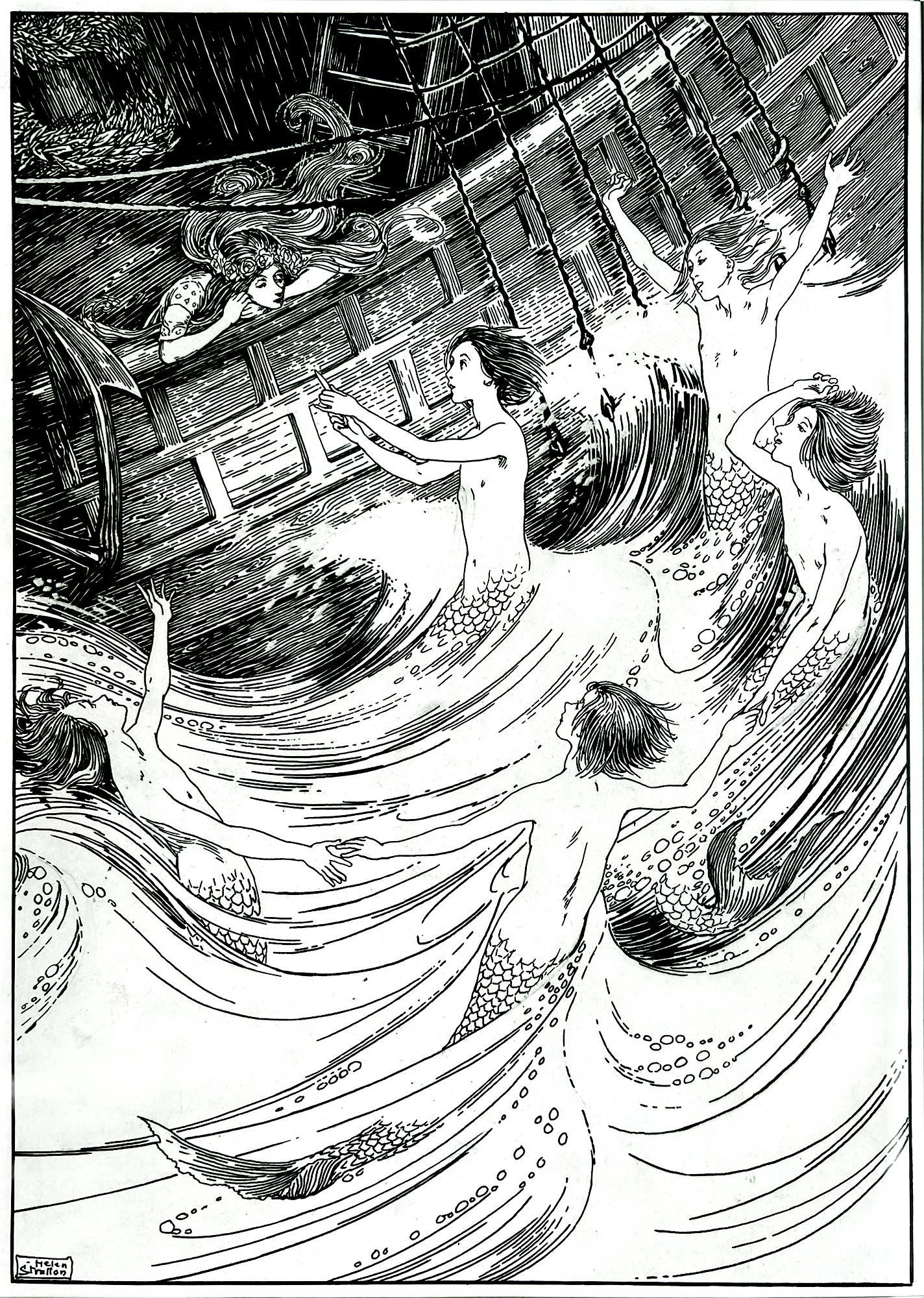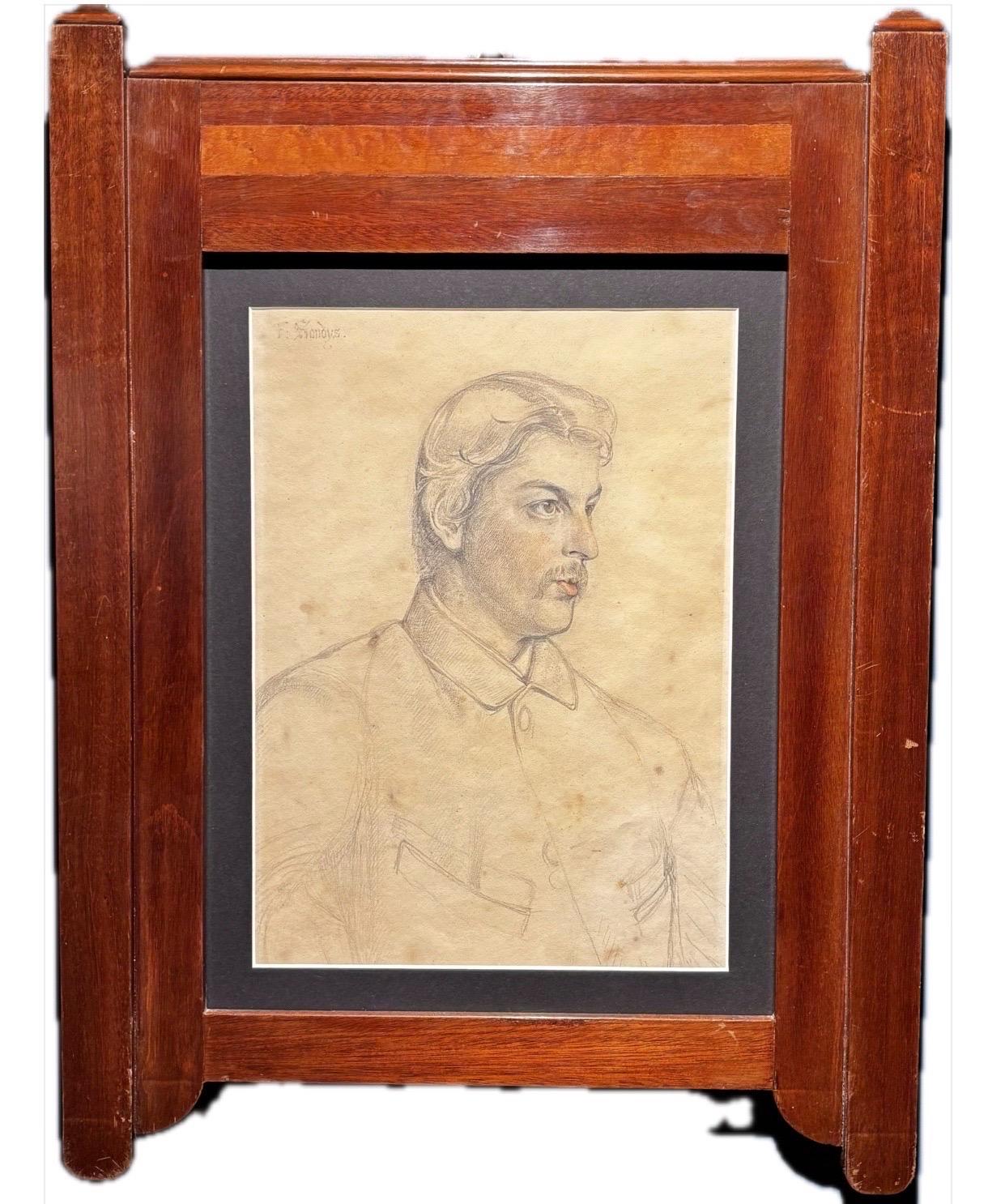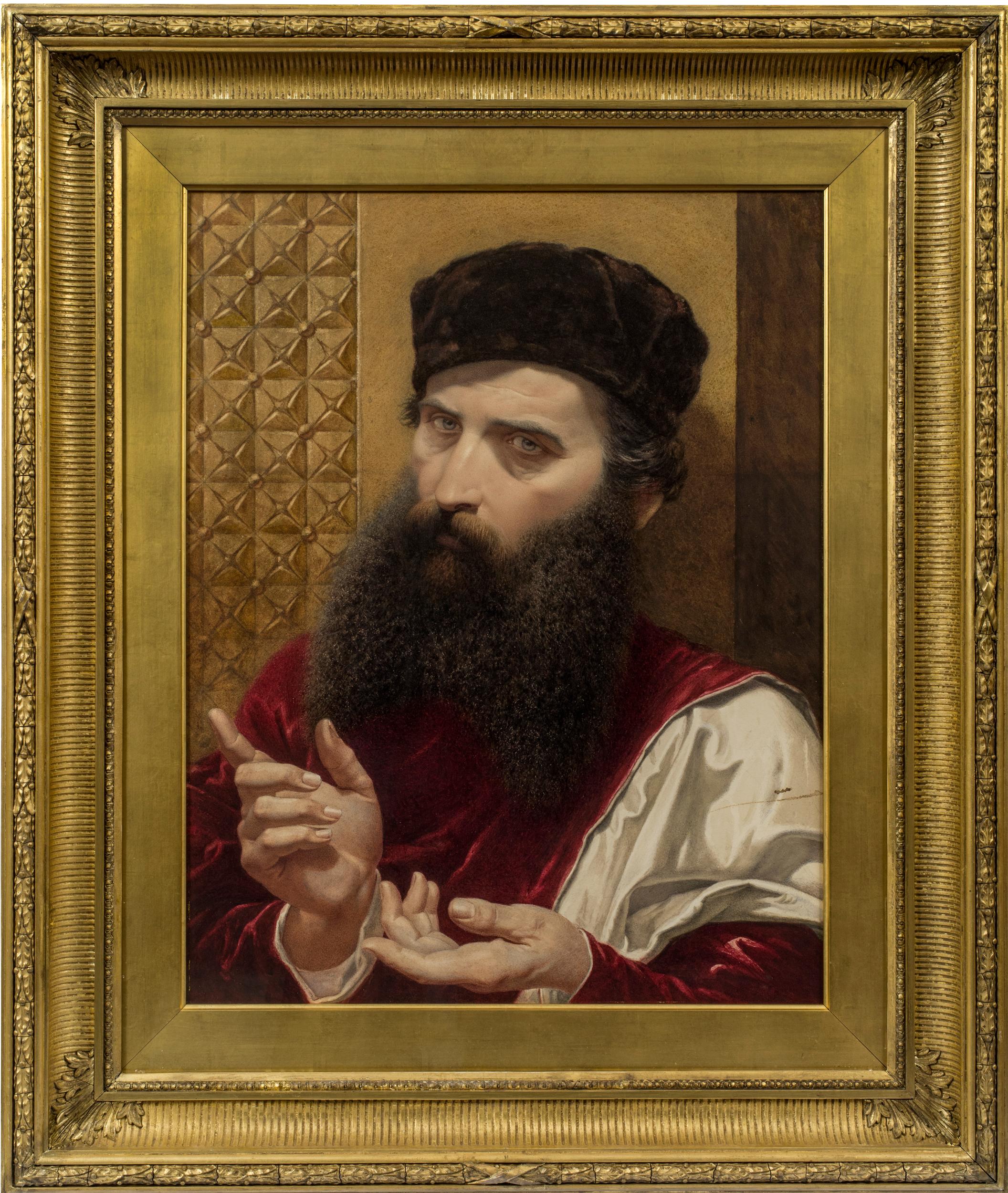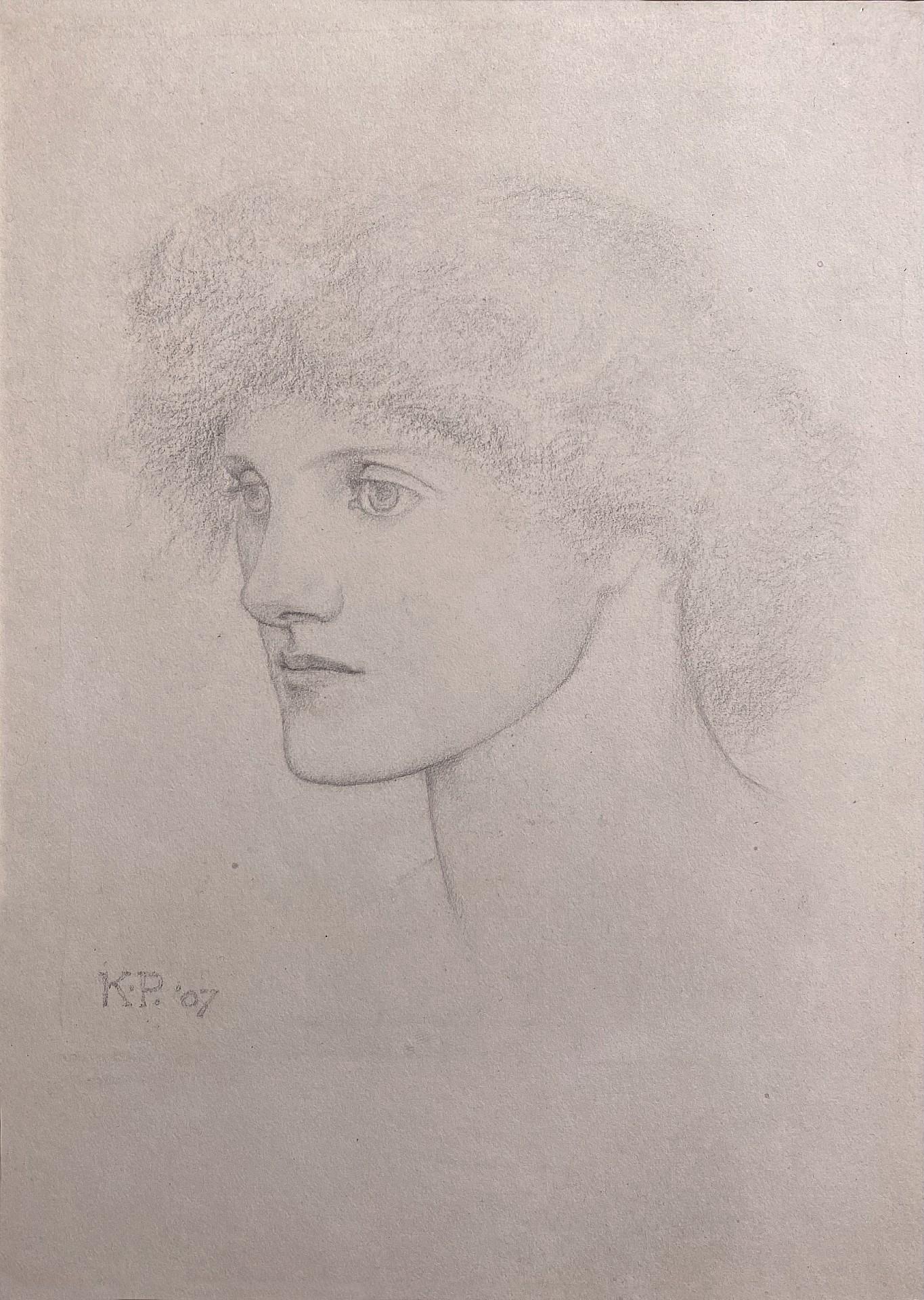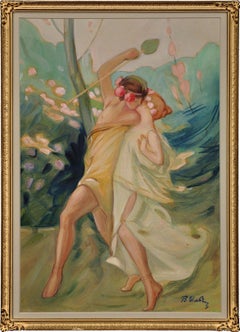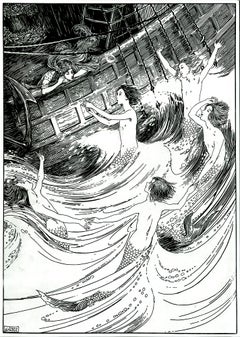Items Similar to Pre-Raphaelite Movement Framed 1880s Sanguine Red Chalk Portrait Drawing
Want more images or videos?
Request additional images or videos from the seller
1 of 24
Alice Mary ChambersPre-Raphaelite Movement Framed 1880s Sanguine Red Chalk Portrait Drawing
About the Item
Alice Mary Chambers.
English ( b.1855 - d.1920 ).
Portrait Of Rebecca Porter Paddon 1850 – 1915 (nee Somerset).
Red Chalk On Paper.
Signed With Monogram Upper Left.
Image size 17.9 inches x 14.8 inches ( 45.5cm x 37.5cm ).
Frame size 25 inches x 21.9 inches ( 63.5cm x 55.5cm ).
Available for sale; this original sanguine red chalk portrait drawing on paper is by the English female artist Alice Mary Chambers and dates from around 1880 to 1885.
The drawing is presented and supplied in a glazed frame dating from the 1990s which uses a backboard and mount from the 1960s (which is shown in these photographs).
This antique drawing is in very good condition. It is supplied ready to hang and display.
The drawing is signed with the artist’s monogram upper left.
Provenance: By descent through the sitter’s family.
Alice Mary Chambers was a fascinating and significant figure in British artistic circles, and part of the higher echelons of the ‘aesthetic’ phase of the Pre-Raphaelite movement of the late nineteenth century. A contemporary of Evelyn De Morgan, Kate Bounce and Marianne Stokes, she was also a close friend of Charles Augustus Howell through whom she met Algernon Swinburne, Whistler and Dante Gabrielle Rossetti. The influence of Burne-Jones, Holman Hunt and E.R. Hughes can also be seen in her highly acclaimed red chalk studies and watercolour works.
Alice was born in Harlow, Essex, in 1855, the daughter of the Rev John Charles Chambers, a controversial figure in the Anglican Church, and his wife, Mary. Their two older children had both died in infancy in 1852. At the time of her birth, Alice’s father was vicar of St Mary Magdalene in Harlow, but in 1856 he became perpetual curate of St. Mary’s, Crown Street, and warden of the House of Charity, both in Soho, London, and he retained these positions until his death. He has been described as turning St Mary’s into a model for managing a parish along ritualist (Anglo-Catholic) lines. By consent, he and his wife separated ‘each to live crypto-monastic lives of celibacy and charity’.
Census records show that in 1861 Alice and her mother were living at Fernley Bank, West Hill, Sydenham, a school for young ladies run by her mother’s sisters, Sarah, Martha and Ann, and at which her mother also taught.
By 1871 Alice and her mother were again living with her father, in Bloomsbury. However, within the next three years, both her parents died. In his will her father made his brother, who was vicar of Hook in Yorkshire, guardian of Alice and left the income from a substantial sum for her maintenance and education. It appears this enabled her to complete her studies.
Alice had emerged as an artist by 1875, when she produced her earliest dated work. She exhibited at the Royal Academy (9 works), and the New Watercolour Society and the New Gallery, London between 1881-1894. She specialised in drawings of female figures and mythological and orientalist subjects. She also provided frontispiece illustration for Mary Hullah’s The Lion Battalion (1885), a collection of stories for children. Chambers signed her work with a monogram which is reminiscent of Rossetti’s, and often used a leafy backdrop.
By 1881 Chambers had established a close relationship with the artists’ agent, Charles Augustus Howell, who is considered one of the most colourful characters of the Victorian age. Howell was the friend and agent of Dante Gabriel Rossetti, and later secretary to John Ruskin. He had a mixed reputation during his lifetime, as both a ‘gifted raconteur’ and a ‘prodigious liar’. Chambers became a member of a close circle around Howell, that also included his wife, Kitty, and his mistresses, the artist Rosa Corder and Clara Vaughan. It has been suggested that Chambers was the third of these mistresses, though she somehow managed to retain her respectability.
Chambers was at her most artistically productive during the years of her friendship with Howell and his circle, benefitting from the support of a like-minded community. By 1881 she was living at 17 Red Lion Square, an address with significant Pre-Raphaelite associations – and described herself an “artist in drawing and painting’. Previous lodgers at 17 Red Lion Square included Dante Gabriel Rossetti, W.H.Deverall, and Edward Burne-Jones. It was also the premises at which (William) Morris, Marshall, Faulkner & Co established their first headquarters.
When Howell died in 1890, he and Chambers were living at the same address in Southampton Row, and possibly in a ménage with Rosa Corder. Chambers was obviously a most trusted friend as she was named as one of the two executors and trustees of his will, along with the auctioneer, Frederick John Bonham, and as one of the two guardians of his daughter by Kitty, along with Corder. It was Chambers who made the arrangements for Howell’s funeral and the sale of his estate.
Following Howell’s death and through the 1890s Chambers appears to have led a peripatetic life and spent much of her time in France and Spain
In 1901 she was living at 15 Ann’s Villas, in West London, and described herself in the census at living on her own means, rather than as an artist. From that time, she retained one or more addresses in London, but spent most of her time in a cottage in Sussex, or abroad in Italy or Spain.
In 1913 Chambers donated Dante Gabriel Rossetti’s plaster death mask to the National Portrait Gallery.
Alice Chambers died at Pomona House, Fulham on 5 May 1920.
© Big Sky Fine Art
There is a tantalizing link between the artist and the sitter of this drawing; they were both remarkable women in their time, with only five years between them in age, and they had the same lifespan of 65 years. They would have mixed in similar social circles and from what is known of their individual lives it is easy to imagine that they would have admired and respected each other. They obviously spent time together when Rebecca sat for her portrait. From the appearance of the subject, it can be reasonably estimated that the picture was created around 1880-85, when the artist would have been around 25-30 and the subject around 30-35. There are two likely circumstances in which this picture may have been commissioned. The first is the occasion of the marriage of Rebecca to her second husband, art collector Samuel Paddon, in 1879. In this scenario, this would have been a romantic gesture, to capture the beauty of the bride. The second scenario is a more pragmatic one; in 1885, six years after marrying Rebecca, Samuel Paddon sued the infamous artist’s agent Charles Augustus Howell. As a close friend, and possibly lover of Howell, Chambers provided promissory notes to help settle the claim. So, this portrait may have been undertaken as part of that settlement. Whatever the circumstances of its creation, this drawing demonstrates the extraordinary skill of one enlightened young woman by capturing the spirit of another.
© Big Sky Fine Art
This truly beautiful original red chalk drawing on paper by Alice Mary Chambers (1855-1920) is a half-length portrait of Rebecca Porter Paddon, nee Somerset, (1850-1915). It is signed with the artist’s usual monogram in the upper left section. Chambers was well-known for her red chalk studies, and this is a very fine example of her work.
The beautiful young woman who is the subject of this drawing is Rebecca Porter Somerset Paddon and her own story merits telling too:
Rebecca was born at Wootton Bassett in Wiltshire in 1850, the daughter of Edmund Thomas Somerset and Mary Ann Somerset. She married Charles John Paddison on 24 June 1874, but three years later she filed for divorce on the grounds of his cruelty and adultery. She also sought custody of their son, born in 1875. The divorce became final in 1879. Until the 1857 Matrimonial Causes Act it was essentially impossible to obtain a divorce without the passage of a private Act through Parliament. Even after 1857 divorce was extremely rare in England, and for a woman to divorce her husband was virtually unheard off. The fact that Rebecca was courageous enough to initiate and see this process through speaks volumes of her character.
Two years after her divorce Rebecca married again, on 17 May 1879. Her second husband, Samuel Wreford Paddon was a diamond merchant and art collector. They went on to have three children together ; Eva, Stanley and Philip. Samuel Paddon was an associate of Charles Augustus Howell, and through him was introduced to Whistler. At this time the Paddons were living in Reigate, Surrey. Rebecca is known to have liked pastel drawings, and bought one from Whistler, possibly from the Venice Pastels exhibition of 1881. During the 1880s the Paddons lived at 55 Earls Court Square, London. Samuel Paddon eventually fell out with Howell over some black Chinese ware he had bought from him, which Howells had described as very rare. However, Paddon had discovered the same pots in an Oxford Street shop for very little. There was also a dispute, published in 1882 in correspondence known as the Paddon Papers: The Owl and the Cabinet. This concerned the ownership and whereabouts of a Chinese cabinet. This marked the end of relations between Paddon and Howell. In 1885 Paddon took legal action against Howell for fraud (and Alice Mary Chambers provided promissory notes on behalf of Howell.).
Rebecca Paddon died on 9 August 1905 (aged 54-55) in Hamstead in the borough of Camden, London. She is buried at West Norwood Cemetery, Lambeth.
© Big Sky Fine Art
- Creator:Alice Mary Chambers (1855 - 1920, English)
- Dimensions:Height: 25.01 in (63.5 cm)Width: 21.86 in (55.5 cm)Depth: 1.38 in (3.5 cm)
- Medium:
- Movement & Style:
- Period:
- Condition:The drawing is presented and supplied in a glazed frame dating from the 1990s which uses a backboard and mount from the 1960s (all of which is shown in these photographs). This antique drawing is in very good condition. It is supplied ready to hang.
- Gallery Location:Sutton Poyntz, GB
- Reference Number:1stDibs: LU489314374682
About the Seller
5.0
Vetted Professional Seller
Every seller passes strict standards for authenticity and reliability
Established in 2010
1stDibs seller since 2016
120 sales on 1stDibs
Typical response time: 1 hour
- ShippingRetrieving quote...Shipping from: Sutton Poyntz, United Kingdom
- Return Policy
Authenticity Guarantee
In the unlikely event there’s an issue with an item’s authenticity, contact us within 1 year for a full refund. DetailsMoney-Back Guarantee
If your item is not as described, is damaged in transit, or does not arrive, contact us within 7 days for a full refund. Details24-Hour Cancellation
You have a 24-hour grace period in which to reconsider your purchase, with no questions asked.Vetted Professional Sellers
Our world-class sellers must adhere to strict standards for service and quality, maintaining the integrity of our listings.Price-Match Guarantee
If you find that a seller listed the same item for a lower price elsewhere, we’ll match it.Trusted Global Delivery
Our best-in-class carrier network provides specialized shipping options worldwide, including custom delivery.More From This Seller
View AllTom Jones Portrait Brilliant & Popular As Ever And Is Truly The Voice! Team Tom
By Andrew Read
Located in Sutton Poyntz, Dorset
Available for sale; this original watercolor portrait is by Andrew Read and is dated 2012.
The painting is mounted within a glazed frame (which is shown in these photographs).
The f...
Category
21st Century and Contemporary Naturalistic Portrait Drawings and Waterco...
Materials
Paper, Watercolor
$1,824 Sale Price
30% Off
Mother And Child 20TH Century Framed Bold Accomplished Stand Out Modern Artwork
Located in Sutton Poyntz, Dorset
Unknown School.
Second half of the mid-20th Century.
Charcoal, Oil Paint & Spray Paint On Plywood Panel.
Signed Indistinctly.
Image size 26.8 inches x 21.7 inches ( 68cm x 55cm )....
Category
20th Century Modern Portrait Drawings and Watercolors
Materials
Plywood, Charcoal, Oil, Spray Paint
$4,798 Sale Price
30% Off
Trotting Horses Harnessed To A Lightweight Four Wheel Cart Trap Framed Original
By Cecil Charles Windsor Aldin, R.B.A.
Located in Sutton Poyntz, Dorset
Cecil Charles Windsor Aldin.
English ( b.1870 - d.1935 ).
Trotting Horses Harnessed To A Lightweight Four Wheel Cart Trap.
Chalk On Paper.
Signed Lower Right.
Image size 19.3 inche...
Category
Early 20th Century Art Nouveau Animal Drawings and Watercolors
Materials
Paper, Chalk
Framed Art Nouveau Period Painting A Greek Love Affair Theseus And Ariadne
By Antoine Calbet
Located in Sutton Poyntz, Dorset
Follower of Antoine Calbet.
French ( b.1860 - d.1944 ).
Theseus and Ariadne, Circa 1890 - 1910.
Mixed Media.
Watercolour, Gouache & Pastel
Image size 16.5 inches x 11.2 inches ( 42cm...
Category
Early 1900s Art Nouveau Figurative Paintings
Materials
Paper, Pastel, Watercolor, Gouache
1940s Wartime Still Life Watercolor Painting By A Famous Ceramic Potter Sculptor
Located in Sutton Poyntz, Dorset
James Tower.
English ( b.1919 - d.1988 ).
Still Life Of Flowers In A Jug And A Plate Of Fruit.
Watercolor & Ink.
Image size 15.4 inches x 13 inches ( 39cm x 33cm ).
Frame size 22.2 ...
Category
Mid-20th Century Post-Impressionist Still-life Drawings and Watercolors
Materials
Paper, Ink, Watercolor
Pre-Second Republic Academic Study Of A Male Nude Framed 1840s French Drawing
Located in Sutton Poyntz, Dorset
Henry Arthur Roberts.
French ( b.1819 - d.1900 ).
Academic Life Study Of A Standing Male Nude.
Pencil & Charcoal On Paper.
Paper size 23.8 inches x 13.6 inches ( 60.5cm x 34.5cm ).
Frame size 28.3 inches x 18.7 inches ( 72cm x 47.5cm ).
Available for sale; this academic life drawing of a male nude is by the French artist Henry Arthur Roberts and dates from the early 1840s.
The drawing is presented and supplied in a modest hand painted glazed wooden frame dating from the mid-20th century (which is shown in these photographs).
This antique drawing is in good condition, commensurate with its age. It is in an untouched condition having never been restored. The paper has handling marks, some light surface dirt, the odd foxing mark and general age toning. The overall patina adds to the aesthetic and is supplied ready to hang and display.
The drawing is not signed but came from a portfolio of drawings by Henry Arthur Roberts.
Henry Arthur Roberts was a recognised French artist, notable for his portraits and paintings of religious subjects. Born in Paris in 1819, he was the son of British watercolour artist James Roberts, himself active in Paris from 1819 -1846. Henry became a student of his father.
Henry Roberts’s talent as a young man was such that he was accepted as a student of Michel Martin Drölling and worked extensively with him. Drölling, the highly acclaimed neoclassic artist (1786-1851) was noted for his theatrical paintings of history and grand portraits. He produced many notable works, including a ceiling work for the Louvre, and works in the Palace of Versailles. Roberts would have studied with Drölling at an early stage in his career, as Drölling died when Roberts was 32. Learning with such a master would have had a huge impact on Roberts in terms of his academic skills and his own emerging style.
Roberts exhibited at the Salon de Paris from 1839, when he was only 20 years old, right through to 1867. His work in the Universal Exhibition of 1855 won him a Third Class Medal. He became Vice-President of the Association of Artists in Paris and in July 1898 he was elevated to the rank of Knight of the Legion of Honour with a foreign title. This was the highest state honour available to him, in recognition of his status as an artist.
Henry Roberts died in 1900, but his legacy lives on, with works in many famous public collections, including the Musée Carnavalet, the Musée du Louvre, the Musée d’Orsay, Musée des Beaux-Arts, Orsay, and in Boston, USA.
© Big Sky Fine Art
This exceptional academic nude...
Category
1840s Academic Nude Drawings and Watercolors
Materials
Paper, Charcoal, Pencil
You May Also Like
Portrait of Elaine Blunt - British 19th century art Pre-Raphaelite chalk drawing
By Edward Robert Hughes
Located in London, GB
This captivating Victorian sanguine chalk portrait drawing of a young girl is by Pre-Raphaelite British artist Edward Robert Hughes. Signed and dated 1896, Hughes depicts in great detail her sweet young face and beautiful dress which appears to almost glow with light. A full length portrait and a really lovely drawing epitomising childhood innocence. The portrait depicts Elaine Blunt and has an inscription from Edward Hughes verso.
Signed and dated lower right.
Provenance. Colchester estate.
Sotheby Lot 283 29th June 1976
Chapman Bros
Condition. Sanguine chalk on paper, 28 inches by 20 inches unframed and in good condition.
Housed in a glazed oak frame, 37 inches by 29 inches framed and in good condition.
Edward Robert Hughes - Not to be confused with Edward Hughes (1832 - 1908), who specialised in portrait painting. Edward Robert Hughes RWS (1851 – 1914) was an English painter who worked prominently in watercolours, but also produced a number of significant oil paintings. He was influenced by his uncle and eminent artist, Arthur Hughes who was associated with the Pre-Raphaelite Brotherhood, and worked closely with one of the Brotherhood's founders, William Holman Hunt. Having settled on his career choice, Edward Robert Hughes attended Heatherley's in London to prepare himself for the chance of auditioning for the Royal Academy School. Hughes became a student at the Royal Academy School in 1868. While Pre-Raphaelitism played an influential part in shaping Hughes work, Aestheticism is also seen in his paintings. E.R. Hughes is widely known for his works Midsummer Eve and Night With Her Train of Stars yet he built a career as a portrait painter to the upper classes. In addition to being an accomplished artist himself, E.R. Hughes was also a studio assistant to the elder artist and Pre-Raphaelite Brotherhood founding member William Holman Hunt when Hunt suffered from glaucoma. Two of the paintings that Hughes worked on with Hunt were The Light of the World, which is displayed in St Paul's Cathedral, and The Lady of Shalott, which is exhibited at the Wadsworth Atheneum. On his own he experimented with ambitious techniques and was a perfectionist; he did numerous studies for many of his paintings, some of which turned out to be good enough for exhibition. Hughes held several important offices within the artistic community over his lifetime such as becoming a member of the Art Workers Guild in 1888, and was on their committee from 1895 to 1897. He was elected to Associate Membership of The Royal Water Colour Society (ARWS) on 18 February 1891, and he chose as his diploma work for election to full membership a mystical piece (Oh, What's That in the Hollow?) inspired by a verse by Christina Rossetti entitled Amor Mundi. His painting A Witch was given by the Royal Watercolour Society to King Edward VII and Queen Alexandra to mark the coronation in 1902. In later years Hughes served as the Vice-President of the RWS before leaving in 1903. Throughout his career, E.R. Hughes exhibited his works in several galleries around London: Dudley Gallery, Grosvenor Gallery, New Gallery, The Royal Academy, and toward the end of his career he exhibited with The Royal Society of Painters in Water Colours (RWS). His works can be seen in public collections including Cartwright Hall, Bradford, Cambridge & County Folk Museum, Maidstone Museum & Art Gallery, Bruce Castle...
Category
19th Century Pre-Raphaelite Portrait Drawings and Watercolors
Materials
Chalk
Portrait of Mildred - British Victorian art Pre-Raphaelite seated young girl
By Edward Robert Hughes
Located in London, GB
This captivating Victorian sanguine portrait drawing of a young girl is by Pre-Raphaelite British artist Edward Robert Hughes. The red chalk portrait dated 1885 is of Mildred, her name inscribed upper left. She is seated, hands in lap, her long hair flowing over her shoulders in typical Pre-Raphaelite manner. Great detail has gone into depicting the smocking on her dress and the artist has perfectly captured her sweet innocent nature.
Signed and dated lower left.
Provenance. Cambridge collection.
Condition. Red chalk on paper, image size 22 inches by 18 inches and in good condition.
Housed in a complimentary frame and glazed, 28 inches by 24 inches framed and in very good condition.
Edward Robert Hughes - Not to be confused with Edward Hughes (1832 - 1908), who specialised in portrait painting. Edward Robert Hughes RWS (1851 – 1914) was an English painter who worked prominently in watercolours, but also produced a number of significant oil paintings. He was influenced by his uncle and eminent artist, Arthur Hughes who was associated with the Pre-Raphaelite Brotherhood, and worked closely with one of the Brotherhood's founders, William Holman Hunt. Having settled on his career choice, Edward Robert Hughes attended Heatherley's in London to prepare himself for the chance of auditioning for the Royal Academy School. Hughes became a student at the Royal Academy School in 1868. While Pre-Raphaelitism played an influential part in shaping Hughes work, Aestheticism is also seen in his paintings. E.R.Hughes is widely known for his works Midsummer Eve and Night With Her Train of Stars yet he built a career as a portrait painter to the upper classes. In addition to being an accomplished artist himself, E.R.Hughes was also a studio assistant to the elder artist and Pre-Raphaelite Brotherhood founding member William Holman Hunt when Hunt suffered from glaucoma. Two of the paintings that Hughes worked on with Hunt were The Light of the World, which is displayed in St Paul's Cathedral, and The Lady of Shalott, which is exhibited at the Wadsworth Atheneum. On his own he experimented with ambitious techniques and was a perfectionist; he did numerous studies for many of his paintings, some of which turned out to be good enough for exhibition. Hughes held several important offices within the artistic community over his lifetime such as becoming a member of the Art Workers Guild in 1888, and was on their committee from 1895 to 1897. He was elected to Associate Membership of The Royal Water Colour Society (ARWS) on 18 February 1891, and he chose as his diploma work for election to full membership a mystical piece (Oh, What's That in the Hollow?) inspired by a verse by Christina Rossetti entitled Amor Mundi. His painting A Witch was given by the Royal Watercolour Society to King Edward VII and Queen Alexandra to mark the coronation in 1902. In later years Hughes served as the Vice-President of the RWS before leaving in 1903. Throughout his career, E.R.Hughes exhibited his works in several galleries around London: Dudley Gallery, Grosvenor Gallery, New Gallery, The Royal Academy, and toward the end of his career he exhibited with The Royal Society of Painters in Water Colours (RWS). His works can be seen in public collections including Cartwright Hall, Bradford, Cambridge & County Folk Museum, Maidstone Museum & Art Gallery, Bruce Castle...
Category
19th Century Pre-Raphaelite Portrait Drawings and Watercolors
Materials
Chalk
The Little Mermaid - Fairy Tales - English Female Illustrator Pen and Ink
Located in Miami, FL
Pioneering English Female Illustrator Helen Stratton masterfully renders in pen and ink a scene from "The Little Mermaid" in George Newnes's 1899 editi...
Category
1890s Pre-Raphaelite Figurative Drawings and Watercolors
Materials
Paper, Ink, Pen
" Studio per ritratto di Philip Bedingfeld" 1870 ca cm. 25 x 36
Located in Torino, IT
Studio a matita e pastelli per lo splendido ritratto di Philip Bedingfeld proprietà del Museo del Norfolk
Frederick Sandys, (Norwich, 1º maggio1829 ...
Category
1870s Pre-Raphaelite Portrait Drawings and Watercolors
Materials
Crayon, Graphite, Paper
$7,496 Sale Price
35% Off
Free Shipping
The Argument
Located in New York, NY
Signed and inscribed on a label on the verso:
No. 1/ The Argument/ W. Cave Thomas/ 203 Camden Rd/ NW
Provenance:
Christie’s, London, 6 November 1995, lot 88.
Private Collection, London.
This powerful watercolor is a mature work by the little-known Victorian painter William Cave Thomas...
Category
19th Century Pre-Raphaelite Portrait Drawings and Watercolors
Materials
Paper, Watercolor, Pencil
Head of a Young Woman
Located in London, GB
Karl Parsons
English 1884 - 1934
Head of a Young Woman
Graphite on paper
Signed and dated '(19)07' lower left
Image size: 6 1/4 x 8 1/2 inches (16 x 21.5 cm)
Contemporary Pre-Raphaelite style frame
One of Britain's leading stained glass designers during the early decades of the 20th century, Karl Parsons drew portraits invariably for pleasure rather than commissions, throughout his life, and it is in these that one sees most clearly the influence of some of the artists whom he most admired, notably Botticelli, Rossetti and Burne-Jones.
Though harkening back to these illustrious forebears, both technically and compositionally, this portrait also epitomises the type of portraiture that was fashionable in British high society at the start of the 20th century. Karl Parson's technique here, with delicate shading and strong outlines, is certainly comparable to Gerald Leslie Brockhurst's graphic style. It is clear that Parsons took delight in demonstrating his skill at sculpting human forms through gentle shading.
Karl Parsons was an English stained glass artist associated with the arts and craft movement. Parsons was born in Peckham in Surrey in 1884, the 12th child of Arthur William Parsons...
Category
Early 20th Century Pre-Raphaelite Portrait Drawings and Watercolors
Materials
Graphite
Recently Viewed
View AllMore Ways To Browse
Antique Framing Square
Antique Shop Drawing
1990s Framed Photographs
Drawings Framed In Antique
Alice Was
Red Lion
25 X 35 Frame
19th Century Academy Drawing
Fine Art 1880s
French Pastel Portraits
Chalk Study
De Morgan
35 X 5 Frame
Portrait Oxford
Antique Chambers
Victorian House Drawing
Mother Mary Art
Portraits Father Daughters


